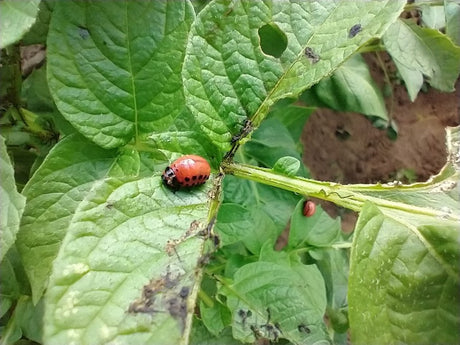What is sambal - Introduction to making sambal
Every year around August, beautiful
peppers appear on social media channels. Red
peppers , long
peppers , mild
peppers , ... Have you ever wondered what happens to all those homemade
peppers ? I asked myself that question in recent years and a whole new world opened up for me. There are also solutions for people who don't like too spicy (mild
peppers and low doses).
Peppers can be prepared in many ways. You can dry them and grind them into
pepper flakes (coarsely ground) or
pepper powder (finely ground). I also use the milder
peppers raw in salads or I process them pure in wok dishes. Working in the kitchen with
peppers is very delicate. Anyone who has ever rubbed their eyes after deseeding
peppers without gloves will know exactly what I am talking about. In the Eastern kitchen, a lot of
peppers are used. In order not to be exposed to 'capsaicin', the substance in a
pepper that determines the spiciness, they make sauces in Indonesia and Malaysia that they can then process in their food without coming into contact with capsaicin. The collective name for these sauces is
sambal . It exists in many different forms but has 1 thing in common ... hot, hotter, hottest. In this article everything about making
sambal yourself.
It is best to handle
peppers with gloves
What is sambal - Basic principles of sambal
Sambal literally means 'addition to a dish'. Just as we add ketchup or mustard to our dish, in Malaysia and Indonesia you add
sambal to your food. Traditionally,
sambal is made in a mortar and pestle as you would make an Italian pesto. The basic ingredients are chili
peppers , garlic,
shallots and tomatoes.
Sambal can be used raw in the 'ketchup way' but also in a warm preparation such as in stir-fries.
Sambal is often supplemented with shrimp paste and fish sauce in warm dishes. You can easily store
sambal in a glass jar in the refrigerator for a few weeks. You can also freeze small portions and use them throughout the year. You can also buy
sambal in the store, then the sauce is usually more liquid and more homogeneous in structure. Making fresh
sambal yourself is highly recommended. You can also make
sambal in many ways. More about that later
How to Make Sambal - Which Peppers Can You Grow and Use to Make Sambal
Traditionally,
sambal is made with Spanish
peppers . The
peppers were brought by the Portuguese from Brazil to the Portuguese colonies in Asia and cultivated there. An international phenomenon, that
sambal . Here is a list of the most commonly used
peppers for
sambal :
-
Habanero (also called Adyuma): A blocky, very spicy pepper in red, yellow, orange, brown, ...
-
Cayenne : A shiny, bright red and long pepper .
-
Madame Jeannette : A light yellow, elongated pepper with a jagged shape.
- All kinds of Chili's: Hungarian Yellow Wax , Anaheim, Jalapeno , ...
Here you can find the
pepper seeds and
pepper plants (available to order online from April) from Moestuinweetjes.

The hottest
peppers are not for everyone
How to make sambal - What is the Scoville score for peppers ?
The Scoville score indicates the degree of spiciness of
peppers and
paprika 's. The amount of capsaicin in the fruits is measured using high-tech equipment. The score was named after the American scientist Wilbur Scoville who invented a method to measure spiciness in 1912, although mainly based on taste tests. The tests are now done in laboratories, but scientist Scoville was allowed to keep the name of the new test and scores.
The Scoville ladder ranges from a score of 0 to 3.2 million. At the bottom with a score of 0-100 are the
peppers that are not actually hot
peppers . And then it gets spicier.
0-100 :
peppers
100-1000 : Mild chilies such as Anaheim
1000-10000:
Hungarian Yellow Wax and
Jalapeno Grande
10000-100000:
Cayenne , Apache and Lombardo
100000-600000:
Habanero and
Madame Jeannette
600000-3.2 million: Carolina Reaper,
Pepper
Please note: Not every
pepper has the same Scoville score. A perfectly grown
pepper can achieve a very high score, but if the plant does not have the right growing conditions, the actual score can also be much lower.
How to make sambal - How to grow your own peppers ?
Growing peppers is quite an adventure. For convenience, you can buy plants. These are professionally pre-cultivated plants that produce a lot of fruit in fertile soil. But you can also grow them yourself. A very nice activity, or hobby, for the winter months. On this link you will find a growing guide on how
to grow your own peppers and paprikas. You can also watch the video below in which I film from seed to harvest.
https://www.youtube.com/watch?v=u_2ROEUDPfQ&
How to make sambal - Different types of sambal
According to what I could find information there are more than 750 different types
of sambal but in this chapter we limit ourselves to the most well-known and their ingredients. The proportions are actually according to your own feeling, if you want spicy, add more chilies or hotter chilies. Also the structure and the grinding and chopping are done according to your own feeling. In every region in Indonesia and Malaysia the different sauces are also prepared differently.
Most people know
sambal Oelek, but oelek actually just means 'mortar' and therefore not really a type.
sambal Manis is also not a type but means 'with added sugar'. Just mention this before you start looking for
sambal Oelek and Terasi below
sambal belacan or
sambal terasi is one of the most popular
sambal types you will find in Indonesia. The raw
sambal (made in a mortar) is made with fresh chilies, tomatoes, shrimp paste and
shallots . This type can be eaten with fried fish, chicken or duck.
sambal belacan goes very well with any fried oriental dish.
Sambal Kacang or peanut sauce is also very popular in Indonesia. It is very often served with dumplings. You make this
sambal with ground peanuts, garlic, chili
peppers and candlenut fruits mixed with water.
sambal Bawang is one for the lovers of
garlic and spicy. You don't need much, just fresh
peppers , garlic and salt. Pound well and add some vegetable oil and you can use this sauce as a dip for
fried chicken or tofu.
sambal Kecap or Ketjap is often eaten with lamb satay or grilled fish and grilled chicken. This
sambal is not ground or mortared. It is a mixture of chopped chilies, tomatoes and
shallots to which you add sweet soy sauce and lime juice. Deliciously tasty.
Sambal Lado comes from Padang, West Sumatra. The stuff is very hot and has a bright red color. This
sambal is a version
fried in hot oil. The ingredients are: chopped chili
peppers , garlic,
shallots , onion, tomatoes, salt and lime juice.
Fry everything for a few minutes and you are ready for war.
This
sambal is green, less spicy but certainly not less tasty than its red brothers.
sambal Hijau is made from green chilies, I use the Anaheim for this sauce. First the chopped green chilies are
fried together with
garlic and
shallot . Then you place them in the mortar with a pinch
of pepper and coarse salt.
Are you less able to tolerate the spicy taste of
peppers , but still want to try
sambal ? Then
sambal Bajak is a good starter. It tastes sweet and despite its red color, it might suggest, does not taste that spicy.
Sambal Bajak is made with the same ingredients as
sambal Belacan (fresh chilies, tomatoes, shrimp paste and
shallots ) but you add a tamarind extract that you can find in most supermarkets with an oriental food section. You usually use this
sambal as a dip sauce for oriental fried snacks or home-
fried chicken.
sambal Rica is a very fresh
sambal thanks to the lemongrass. You make the
sambal with crushed chilies,
shallots , ginger and sugar that you fry for a few minutes in vegetable oil. Afterwards you add finely chopped lemongrass and lime juice for the fresh touch.
This
sambal is made with the
sambal Belacan but you add strips of raw mango and lime juice. This way you get a sweet sour spicy sauce ideal with fish that is often too delicate to use the
sambal pure.
Sambal Pecel looks a lot like
Sambal Kacang in its pure form. The appearance may be similar but the taste is certainly not.
Sambal Pecel is made with garlic, shrimp paste, peanuts, of course chili
peppers , kencur (the root of the galangal plant, you can also use ginger), tamarind extract and palm sugar. This
sambal is deliciously sweet and not too spicy thanks to the peanut and the kencur or ginger. It is often eaten with cooked sprouts,
spinach and cabbage.
This popular
sambal comes from Bali. This is a
sambal with raw ingredients, not
fried or ground. So be careful ... The ingredients are
Shallot , chilies, tomatoes, lemongrass and kecombrang (a type of ginger that you can find in specialty stores, you can also use ginger). You can also add some edible flowers here. This colorful
sambal together with its fresh taste brings saliva in your mouth.
Finally
Despite the fact that the basic ingredient of
sambal is the chili
pepper , you can make many different types
of sambal .
Sambal not only adds flavor to your dish, it also reflects the rich culture of Indonesia and Malaysia itself. If you want
to grow your own peppers after reading this article, look for all
the growing information on this site . Have fun growing!
Do you finally know what to do with all those
peppers and did you find this article valuable? Then use the social media buttons on this site to share this information. You can also support us by buying your
pepper seeds or
pepper plants (available from April) here from
our webshop .
Myself in my vegetable garden
Greetings, Tom
 The hottest peppers are not for everyone
The hottest peppers are not for everyone sambal Terasi
sambal Terasi sambal kacang
sambal kacang sambal Bawang
sambal Bawang sambal Kecap
sambal Kecap sambal Lado
sambal Lado sambal hijau
sambal hijau sambal bajak
sambal bajak sambal Rica
sambal Rica sambal pencit
sambal pencit sambal pecel
sambal pecel sambal matah
sambal matah